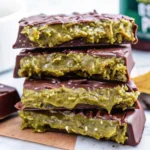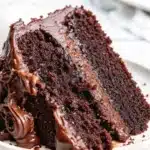Opera cake is more than just a dessert—it’s a masterpiece of French pâtisserie that whispers luxury with every bite. With its perfectly aligned layers of almond sponge soaked in coffee syrup, espresso buttercream, and glossy chocolate ganache, the opera cake is a dessert that looks as grand as its name suggests.
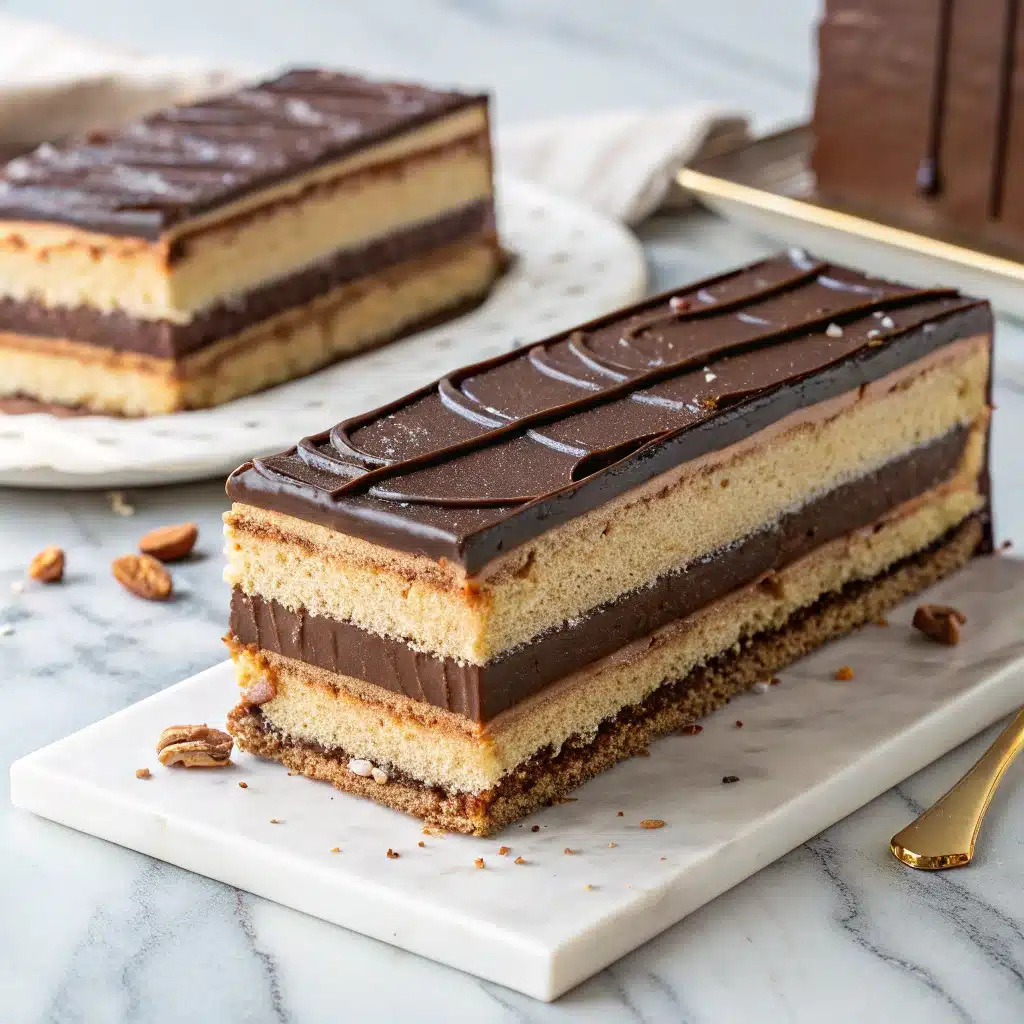
I’m Mary, I live in Bath, and I’m known (proudly) as “The Pudding Lady.”
My baking story didn’t begin in a French patisserie, but in my mother’s cluttered English pantry, where golden syrup stuck to everything and flour floated through the air like dust. That’s where I learned that a proper dessert could heal most woes and that custard—despite its fame—often lets you down. I was that child who hovered near the oven, stole sugar when no one was looking, and always begged to lick the spoon.
I never studied pastry formally—too impatient, too curious. But I baked. Victoria sponges that steamed as you sliced into them, puddings so rich they needed no custard, and tarts that vanished from fête tables before you could blink. Eventually, I started a weekend pudding club right in my own kitchen. No fuss, just six people at a time, endless tea, and flour on every surface.
And even though I specialize in British classics, I have a deep admiration for the precision and beauty of French pastries. That’s why the opera cake holds a special place in my heart. It’s a dessert that demands patience and rewards with grandeur. Discover great ideas like this puff pastry folding tutorial if you want to brush up on the kinds of methods that build such elegance.
Table of Contents
What is an Opera Cake? A Classic French Dessert Explained
Defining the Opera Cake: Origins and Cultural Significance
The opera cake is a French pastry known for its elegant layers and rich, refined taste. Traditionally composed of almond joconde sponge cake, coffee buttercream, and chocolate ganache, it’s finished with a shiny chocolate glaze that mirrors the sophistication of its namesake—the opera.
Invented in the 1950s, many credit its creation to the legendary Parisian patisserie Dalloyau. While stories vary, some say it was named for the Paris Opera due to its layered structure mimicking the tiers of an opera house. Others argue it was designed to be a dessert “worthy of a performance.” One thing’s for sure: its reputation for beauty and balance makes it a showstopper on any dessert table.
Opera cake’s association with high-end dining and meticulous technique makes it a symbol of French culinary artistry, often featured in upscale restaurants and patisserie competitions.
Discover great ideas like this Chocolate Raspberry Cake if you’re drawn to richly layered desserts.
Print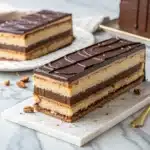
Opera Cake
- Total Time: 55 minutes
- Yield: 8 slices 1x
Description
A classic French dessert with delicate layers of almond sponge, coffee buttercream, and rich chocolate ganache.
Ingredients
- 6 large eggs
- 6 egg whites
- 200g granulated sugar
- 200g almond flour
- 60g all-purpose flour
- 60g unsalted butter, melted
- 200g dark chocolate
- 200ml heavy cream
- 200g unsalted butter, softened
- 100g powdered sugar
- 2 tbsp instant espresso powder
- 1 tbsp water
- 1 tsp vanilla extract
Instructions
- Preheat the oven to 200°C (390°F). Line baking trays with parchment paper.
- Whisk eggs and sugar until pale and fluffy. Fold in almond flour and all-purpose flour.
- In a separate bowl, beat egg whites to stiff peaks and gently fold into the batter.
- Add melted butter and combine gently. Spread batter into prepared trays and bake for 8–10 minutes. Let cool.
- For the coffee buttercream, dissolve espresso powder in water, beat butter with powdered sugar and add the espresso and vanilla. Mix until smooth.
- For the ganache, heat heavy cream, pour over chopped chocolate, and stir until smooth. Let cool slightly.
- To assemble, layer sponge, brush with coffee syrup (optional), spread buttercream, add another sponge, spread ganache, and repeat.
- Finish with a smooth ganache top layer. Chill for several hours or overnight.
- Trim edges for a neat finish and slice to serve.
Notes
Ensure all layers are even and chill thoroughly for clean slicing. Opera Cake is best served slightly chilled.
- Prep Time: 45 minutes
- Cook Time: 10 minutes
- Category: Dessert
- Method: Baking
- Cuisine: French
Nutrition
- Serving Size: 1 slice
- Calories: 550
- Sugar: 32g
- Sodium: 100mg
- Fat: 38g
- Saturated Fat: 20g
- Unsaturated Fat: 16g
- Trans Fat: 0g
- Carbohydrates: 45g
- Fiber: 3g
- Protein: 8g
- Cholesterol: 140mg
Why Is It Called an Opera Cake? Story Behind the Name
So, why is the cake called an opera cake? It all comes down to three theories, each adding a layer (pun intended) to its legacy:
- The Opera Garnier Theory: The dessert’s layered structure mirrors the tiered seating of the grand Paris Opera House, both in form and sophistication.
- Haute Culture Connection: Its elegant composition and balanced flavors were meant to appeal to sophisticated Parisian audiences who attended the opera.
- Branding by Dalloyau: Dalloyau, one of France’s oldest pâtisseries, trademarked the dessert, further linking it to Parisian culinary prestige.
Regardless of which version you believe, the name stuck—and now opera cake is an iconic staple of French patisserie culture.
Learn more about the basics of sponge layering in this Vanilla Cake Recipe, a great starting point for beginners.
Ingredients That Make the Opera Cake Irresistible

Core Ingredients: Joconde Sponge, Ganache, Coffee Syrup & Buttercream
The flavor of opera-cake relies on the harmony of several sophisticated components. Each layer has a specific role, contributing to the texture and depth that define this French classic. Let’s break it down:
| Layer | Ingredient Name | Purpose |
|---|---|---|
| Sponge Base | Almond Joconde Sponge | Light and moist, supports layering |
| Moistening Syrup | Espresso or Coffee Syrup | Adds bold, aromatic flavor |
| Filling | Coffee Buttercream | Rich, smooth, and balances the chocolate |
| Filling | Chocolate Ganache | Intense cocoa depth and structure |
| Topping | Dark Chocolate Glaze | Glossy finish with a satisfying snap |
- Almond Joconde Sponge – This French-style sponge is softer than genoise and gets its signature texture from a combination of almond flour, whole eggs, and whipped egg whites. It’s flexible yet sturdy, perfect for layering.
- Coffee Syrup – A concentrated syrup made from brewed espresso or instant coffee and sugar. It’s brushed generously between layers, enhancing both moisture and bold flavor.
- Coffee Buttercream – A luxurious French-style buttercream using egg yolks, hot sugar syrup, and butter, infused with coffee essence. This creamy layer is central to the opera cake’s identity.
- Chocolate Ganache – Rich and silky, made from dark chocolate and heavy cream. It contrasts beautifully with the bitter notes of the coffee buttercream.
- Chocolate Glaze – A final, shiny layer that’s lightly set. It adds elegance and locks in the moisture of the layers below.
Each element is carefully constructed to complement the others, creating a dessert that is bold, balanced, and incredibly satisfying.
Don’t miss our Heavenly Chocolate Cheesecake Trifle for another multi-layered treat that delights chocolate lovers.
The Role of Coffee and Chocolate in Balancing Flavors
Coffee and chocolate aren’t just in the opera cake for show—they are essential to its personality. Their interaction defines the overall taste experience:
- Coffee: Adds bitter complexity, cutting through the sweetness of buttercream and sponge.
- Chocolate: Brings richness, depth, and a decadent mouthfeel that anchors the cake’s sweetness.
The contrast between these two ingredients is what gives opera-cake its refined edge. While chocolate dominates the top layer, the coffee flavor builds as you move deeper into each bite.
Looking for inspiration? Try our citrus-twist on Italian flavors with this Lemon Tiramisu, a bright alternative to the traditional bitter-sweet flavor profile.
Step-by-Step Guide to Making an Opera Cake at Home
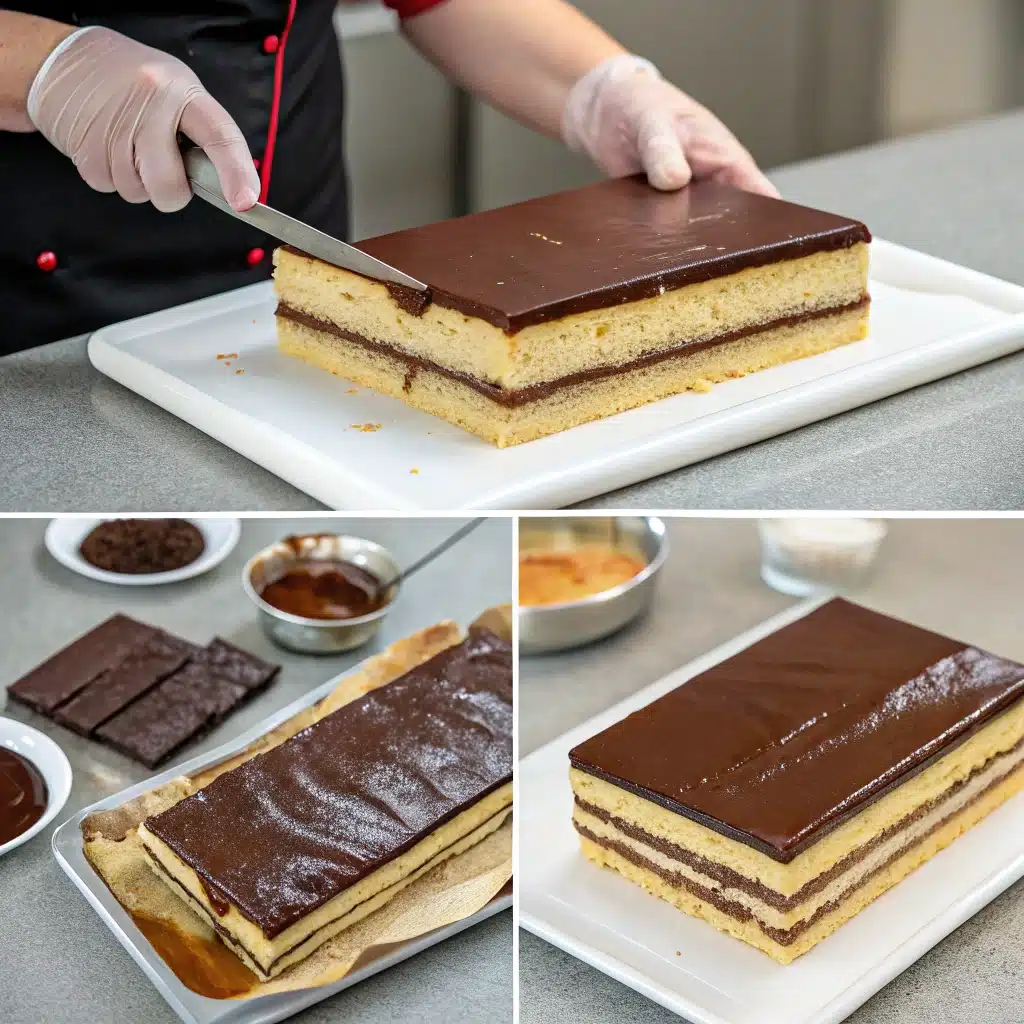
Equipment and Preparation Tips for Beginners
Before diving into this multi-layered masterpiece, it’s essential to gather the right tools and plan your workflow. Opera cake is all about precision and timing. Here’s what you’ll need:
Essential Equipment:
- Jelly roll pan or baking sheet (for thin sponge layers)
- Offset spatula (for smooth buttercream and ganache spreading)
- Stand mixer or electric hand mixer
- Thermometer (for sugar syrup when making buttercream)
- Sharp serrated knife (for trimming clean edges)
- Silicone pastry brush (for applying syrup)
📝 Pro Tips for Smooth Execution:
- Chill between layers: After assembling each layer, chill it briefly to prevent sliding or smearing.
- Weigh ingredients: Accuracy is everything. Use a kitchen scale for best results.
- Work in stages: Make the sponge and syrups a day ahead if needed. Opera cake rewards patience.
Check out these Mini Chocolate Cakes if you’re not ready to tackle a full-sized opera but want a similar layered texture on a smaller scale.
Detailed Recipe with Layer Assembly Instructions
Let’s break the opera cake process into easy-to-follow steps:
1. Make the Almond Joconde Sponge (x3 layers)
Ingredients:
- 6 large eggs
- 6 egg whites
- 1 cup almond flour
- ¾ cup all-purpose flour
- 1 cup powdered sugar
- 2 tbsp melted butter
Instructions:
- Whip eggs with almond flour and sugar until light.
- Fold in flour, then gently mix in beaten egg whites and butter.
- Spread thinly onto parchment-lined pans and bake at 425°F (220°C) for 5–7 minutes.
2. Brew the Coffee Syrup
Ingredients:
- ½ cup espresso or strong coffee
- ⅓ cup sugar
Instructions:
- Heat together until sugar dissolves.
- Cool, then brush over each sponge layer.
3. Prepare the Coffee Buttercream
Ingredients:
- 4 egg yolks
- ½ cup sugar
- 2 tbsp water
- 1 cup unsalted butter
- 2 tsp instant coffee dissolved in 1 tbsp hot water
Instructions:
- Whip yolks. Cook sugar + water to 240°F and pour into yolks while whipping.
- Cool, then whip in butter and coffee until smooth.
4. Make the Chocolate Ganache
Ingredients:
- 8 oz dark chocolate
- ¾ cup heavy cream
Instructions:
- Heat cream to a simmer. Pour over chocolate and let sit. Stir until glossy.
5. Assemble the Layers
- Place one sponge layer on a tray.
- Brush with syrup.
- Spread buttercream.
- Add second sponge, brush, then ganache.
- Add final sponge, brush, then buttercream.
Chill between each layer for 10–15 minutes.
6. Finish with a Shiny Chocolate Glaze
Glaze Ingredients:
- 5 oz dark chocolate
- ¼ cup heavy cream
- 1 tbsp light corn syrup (for shine)
Instructions:
- Pour glaze over top and smooth quickly with a spatula.
- Chill until set.
Slice edges with a hot knife for that signature clean-cut look. You’ve just built an opera cake worthy of a standing ovation.
Variations and Modern Twists on Opera Cake
Vegan, Gluten-Free & Flavored Adaptations (Matcha, Raspberry, etc.)
While the classic opera-cake is a symphony of butter, eggs, and flour, modern pastry chefs have found clever ways to adapt this dessert to suit different dietary needs and flavor preferences.
Vegan Opera Cake
- Sponge: Use aquafaba (chickpea water) and almond flour to create a pliable sponge base.
- Buttercream: Replace classic buttercream with vegan alternatives using dairy-free butter and plant-based milk for a delicious, cruelty-free twist.
- Ganache: Use coconut cream and dairy-free chocolate.
Gluten-Free Opera Cake
- Almond flour already plays a central role, but replace any all-purpose flour with a gluten-free baking blend.
- Be sure to verify chocolate and flavorings are gluten-free certified.
Matcha Opera Cake
This vibrant twist replaces the coffee syrup with matcha tea and adds matcha powder to the sponge and buttercream for a slightly bitter, earthy flavor. The result is both refreshing and elegant.
Raspberry Opera Cake
Infuse the buttercream with raspberry puree and layer the sponge with raspberry coulis. The tartness of the berries contrasts beautifully with the chocolate layers.
Seasonal Flavors
- Pumpkin spice for fall
- Coconut-mango for summer
- Chestnut cream for winter
These twists offer a modern spin on tradition while respecting the layered structure that makes the opera cake iconic.
Don’t miss our Vanilla Cake with Raspberry Filling to see how fruit flavors can enhance cake textures.
Mini Opera Cakes, Opera Cake Jars, and Creative Presentations
Sometimes, smaller truly is better—especially when it comes to elegant desserts. Modern patisserie has made the opera cake more versatile than ever.
Mini Opera Cakes
These bite-sized treats are perfect for parties, buffets, or elegant afternoon teas. Use cookie cutters or square molds to portion individual cakes before glazing.
Opera Cake in a Jar
A casual yet classy presentation ideal for gifting or serving at events. Assemble layers in a mason jar using piping bags for a clean look. It’s a modern twist on a classic structure.
Artistic Presentation Ideas
- Gold leaf topping for luxury appeal
- Cocoa powder stencils or chocolate décor
- Marbled glaze effects using food-safe gold shimmer
Opera cake may be rooted in tradition, but its capacity for reinvention keeps it firmly in the spotlight.
Opera Cake vs. Tiramisu – Key Differences You Should Know
Opera cake and tiramisu are both layered, coffee-infused desserts with European roots—but they’re far from the same. If you’ve ever wondered how these two desserts differ beyond just flavor, this section breaks it all down.
Flavor Profile Comparison: Coffee, Cocoa & Cream Differences
| Aspect | Opera Cake | Tiramisu |
|---|---|---|
| Flavor Base | Rich coffee and dark chocolate | Espresso and cocoa |
| Sweetness | Balanced, slightly bitter | Creamier and sweeter |
| Boldness | Dense and indulgent | Lighter with a mousse-like finish |
| Alcohol Use | Rare (optional) | Often includes Marsala or coffee liqueur |
| Intensity | More structured and refined in taste | Airy and more casual in flavor |
Opera cake presents a sophisticated, multilayered medley of buttercream, ganache, and syrup-infused sponge, resulting in a dessert that’s both luxurious and deeply indulgen. In contrast, tiramisu leans soft and creamy, often relying on mascarpone and whipped cream to do the heavy lifting.
Check out our detailed Tiramisu Cake to explore a sponge-based hybrid between the two classics.
Texture, Ingredients & Origin Breakdown
Let’s dig deeper into the structure and roots of each dessert:
Origins & Culinary Heritage
- Opera Cake: French, created by pastry chefs at Dalloyau in the 1950s.
- Tiramisu: Italian, believed to have originated in the Veneto region during the 1960s.
Structural Differences
- Opera Cake: Uses thin layers of almond joconde sponge alternating with coffee buttercream and chocolate ganache.
- Tiramisu: Relies on ladyfingers soaked in coffee and layered with whipped mascarpone cream.
Baking Method
- Opera Cake: Baked, chilled, and precisely assembled.
- Tiramisu: No-bake, assembled and chilled for setting.
Tiramisu is often viewed as the approachable, casual sibling to the opera cake’s sophisticated and performance-like presence. Both are timeless—but they shine in different culinary contexts.
Discover great ideas like our Romantic Chocolate and Strawberry Cupcakes for other sweets that balance love and flavor beautifully.
Common Mistakes to Avoid When Baking Opera Cake
Overbaking Joconde or Splitting Buttercream
Making an opera-cake isn’t impossible—but it does demand attention to detail. Even experienced bakers can stumble when working with multiple layers and delicate textures. Here’s what to watch out for:
❌ Overbaking the Sponge
Problem: The almond joconde dries out quickly due to its thinness.
Fix: Bake at a high temperature (around 425°F) for a short time—no more than 7 minutes. Remove as soon as the edges turn light golden.
❌ Splitting the Buttercream
Problem: When butter is added too fast or ingredients are at mismatched temperatures, the buttercream can curdle.
Fix: Make sure both your sugar-yolk base and your butter are room temperature. Add butter slowly while beating.
❌ Ganache Too Runny
Problem: If the cream is too hot or ratios are off, your ganache won’t set properly.
Fix: For a richer, thicker consistency, use a 2:1 ratio of chocolate to cream when making your ganache. Let the ganache cool slightly before spreading.
Tips for Proper Layering and Final Glaze
A lopsided or soggy opera cake can undo all your hard work. These layering techniques will help ensure your cake not only tastes great—but looks bakery-worthy.
✅ Chill Between Layers
Each layer—whether buttercream or ganache—should be chilled before adding the next. This prevents sliding, smudging, and collapsing layers.
✅ Use an Offset Spatula
This gives you precision when spreading and ensures each layer is thin and even. Opera cake isn’t about big chunks—it’s about balance.
✅ Trim the Edges
Once assembled and chilled, use a hot serrated knife to trim the cake’s edges for that signature clean, rectangular finish.
✅ Apply the Glaze Quickly
The top chocolate glaze should be poured and smoothed in one motion to maintain a mirror-like shine. Don’t overwork it, or it’ll dull.
Don’t miss our Salted Chocolate Cake if you’re curious how salt can enhance chocolate’s flavor complexity—another pro-level flavor balance!
Serving and Pairing Suggestions for Opera Cake
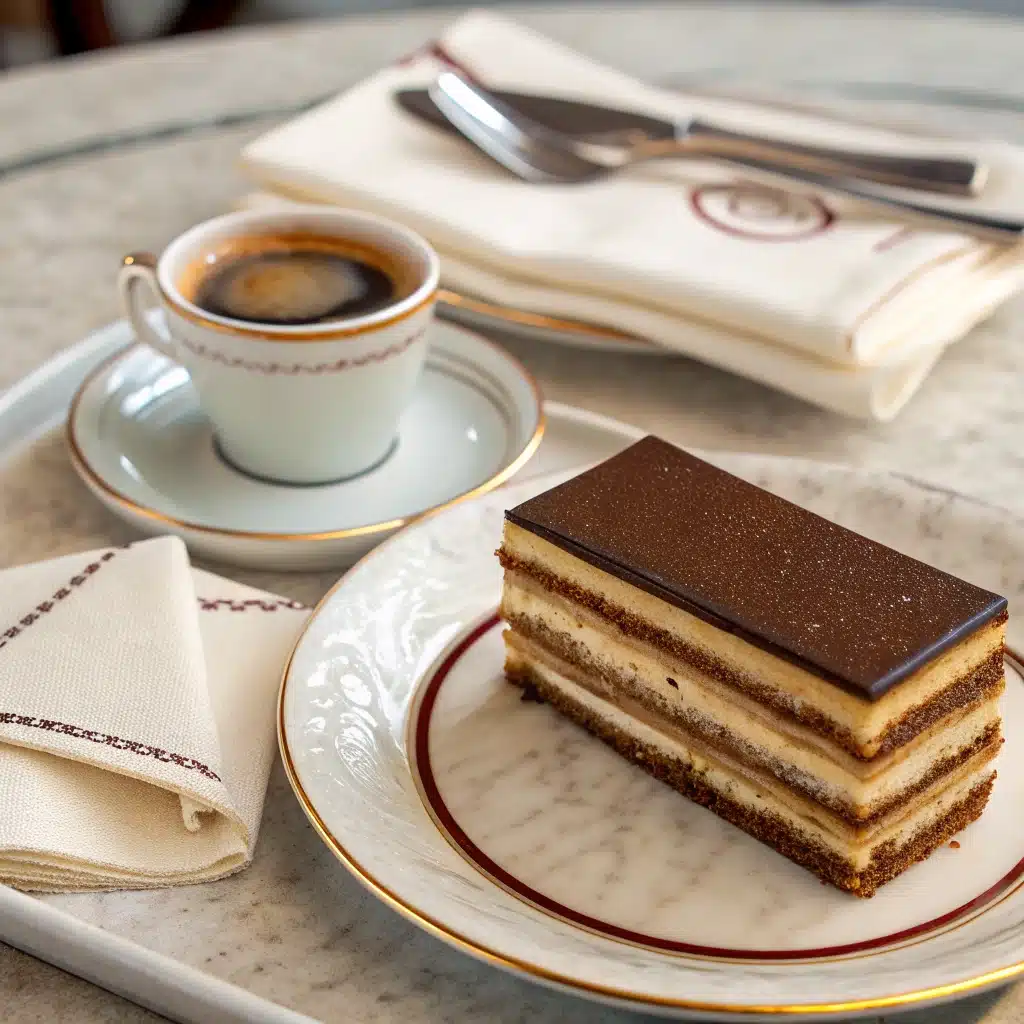
Ideal Serving Temperatures and Portion Sizes
A refined dessert deserves a refined presentation. The way you serve your opera-cake can elevate the tasting experience—from visual appeal to flavor delivery.
Best Serving Temperature
Opera cake should be served slightly chilled, but not straight from the fridge. Remove it 10–15 minutes before serving so the buttercream and ganache soften to the ideal mouthfeel without losing their structure.
How to Cut Clean Slices
- Use a long serrated knife, dipped in hot water and wiped dry before each cut.
- Slice using gentle sawing motions to avoid squashing the layers.
Ideal Portions
Opera cake is rich. A small rectangular slice (approx. 3″ x 1.5″) is plenty for most people. Its elegant shape also makes it perfect for high-end presentation.
Learn more about proper layering and serving size through our beautifully portioned Mini Chocolate Cakes that make every bite count.
Best Drinks to Pair with Opera Cake (Espresso, Dessert Wines, etc.)
Opera cake’s bold coffee-chocolate profile opens the door to several excellent pairing options that enhance its complexity and balance.
Coffee-Based Pairings
- Espresso: Complements the coffee syrup and amplifies the bold notes.
- Café au lait: Softens the intensity for a milder experience.
Alcohol Pairings
- Port Wine: Its dark, fruity richness plays beautifully with ganache.
- Amaretto: Enhances the almond notes in the joconde sponge.
- Baileys or Kahlua: Echo the coffee buttercream’s character.
Non-Alcoholic Options
- Vanilla almond milk for a light, complementary contrast
- Sparkling water with citrus to cleanse the palate between bites
Each pairing brings out a different aspect of the opera cake—from its bitter undertones to its creamy sweetness.
Looking for inspiration? Try our Dubai Pistachio Chocolate Bar for another bold dessert with pairing potential.
Where to Buy or Order Opera Cake Near You
Best Bakeries in the U.S. Making Authentic Opera Cakes
Not everyone has the time—or the courage—to tackle a multilayered pastry at home. Luckily, some of the finest patisseries across the U.S. specialize in the authentic French opera-cake, giving you the chance to enjoy it without the hassle.
Here’s where you can find opera-cake done right:
New York City
- Dominique Ansel Bakery – Known for meticulous layering and bold flavors.
- Bouchon Bakery – A Thomas Keller favorite offering classic French patisserie.
San Francisco
- Tartine Bakery – Offers seasonal variations and beautifully executed traditional slices.
- b. Patisserie – Highly rated for elegant presentation and flavor balance.
Miami
- L’Artisane Creative Bakery – A vegan twist on classic French pastries.
- La Provence – Traditional technique with an upscale flair.
Other Cities
- Tous Les Jours (various U.S. locations) – Offers opera-cake in slice or whole formats.
- Paris Baguette – Celebrated for its Asian-French fusion desserts, including creative takes on classic opera cake.
Check out our rich and satisfying Chocolate Strawberry Cake for another bakery-style treat with a classic flavor combo.
Online Stores & Shipping Options for Opera Cake
Want opera-cake delivered to your door? Several gourmet dessert retailers offer shipping options across the U.S.—perfect for birthdays, celebrations, or just indulgent weekends.
National Delivery Options
| Retailer | Shipping Notes | Customization |
|---|---|---|
| Goldbelly | Delivers from top bakeries across the U.S. | Yes, some flavor options |
| Lady M Confections | Ships elegant cakes with signature packaging | Limited customization |
| La Maison du Chocolat | Premium opera-cake slices with rich ganache | No custom options |
| Williams Sonoma | Seasonal availability, often gourmet-focused | Yes (during holidays) |
Tips for Online Orders:
- Check temperature control options, especially in warmer months.
- Order early for special occasions (2–3 days before).
- Store in the fridge and serve slightly chilled, just like homemade.
Don’t miss our Flourless Chocolate Cake (Vegan) for another delivery-friendly dessert with gourmet appeal.
Conclusion
Elegant, indulgent, and deeply rooted in French patisserie tradition, the opera-cake is more than just a dessert—it’s a layered celebration of flavor and craftsmanship. Whether you make it from scratch or order from a high-end bakery, the experience is always theatrical. With its almond sponge soaked in coffee, rich ganache, and luxurious buttercream, opera cake offers the perfect balance of texture, taste, and visual appeal.
From its fascinating name to its versatile variations, this cake is a true showstopper for dinner parties, birthdays, or any moment you want to impress.
Learn more about classic pairings and inspiration with our Vegan Chocolate Mousse Cake—another dessert that redefines indulgence.
Fore more recipes follow me in Facebook, medium and Pinterest
FAQs
Why are they called opera cakes?
Opera cakes got their name from their structured, elegant layers—believed to resemble the tiered architecture of the Paris Opera House. French pâtissiers designed the cake to reflect refinement and sophistication, much like an opera performance. The name also connects to the French tradition of aligning culinary presentation with cultural grandeur.
Why is the cake called an opera cake?
The term opera cake was reportedly coined by Dalloyau, a prestigious French pâtisserie, in the 1950s. Its rich chocolate glaze, creamy buttercream, and almond sponge mirror the drama and complexity of opera music. The cake’s evenly stacked layers are said to echo the seating balconies in an opera theatre, offering a “stage-like” cross-section when sliced.
What are the ingredients of an opera cake (pastry)?
An opera-cake is made with:
Almond joconde sponge
Coffee syrup
Coffee-flavored French buttercream
Dark chocolate ganache
Chocolate glaze
These ingredients are meticulously layered to create a dessert that is simultaneously light, rich, sweet, and slightly bitter. Many modern variations include raspberry, matcha, or even vegan adaptations.
What is the difference between tiramisu and an opera cake?
While both desserts feature layers and coffee flavors, they differ in many ways:
Opera cake is French, baked, and uses almond sponge, ganache, and buttercream.
Tiramisu is Italian, no-bake, and uses ladyfingers soaked in espresso with mascarpone cream.
Opera cake has a more structured texture and elegant finish, while tiramisu is softer, creamier, and often alcohol-infused.
Learn more about the distinct textures and flavors in our Tiramisu Cups, a fun variation of the classic Italian dessert.


